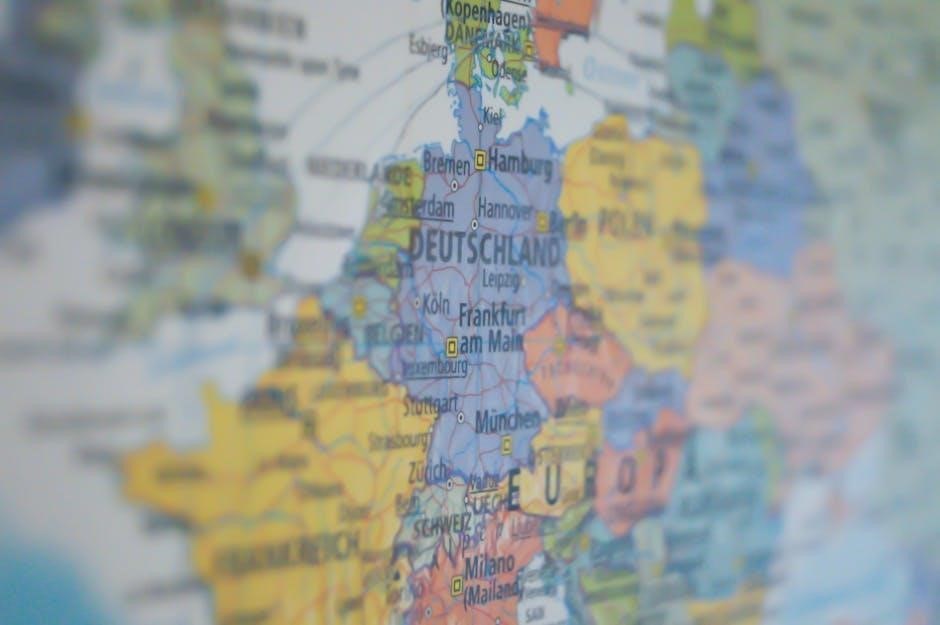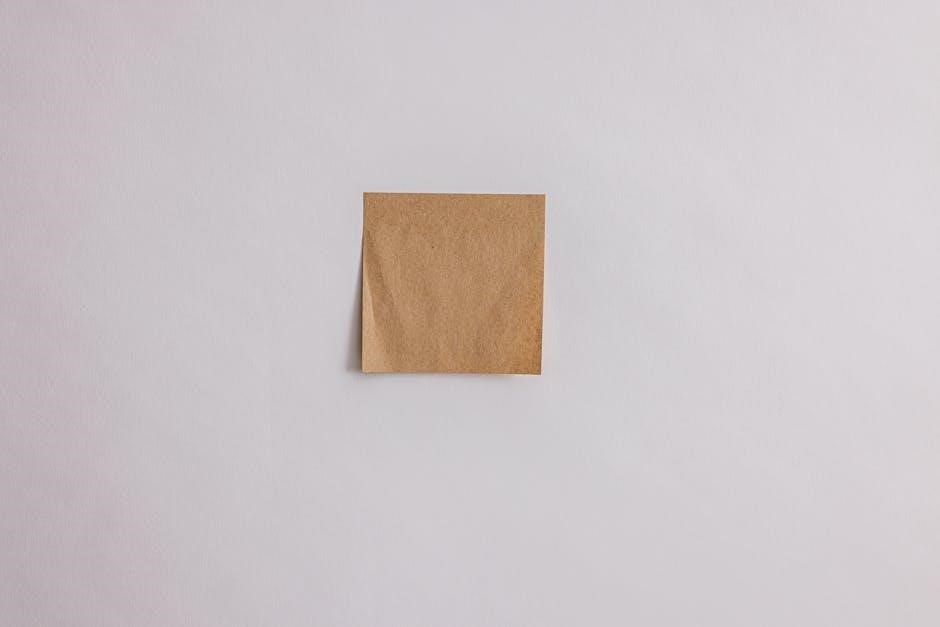
Understanding cardstock weight is essential for any project, as it affects durability, print quality, and usability. This guide explores key factors like GSM, pounds, and thickness to help you choose the right cardstock for your needs.
1.1 Understanding the Importance of Cardstock Weight
Cardstock weight plays a crucial role in determining durability, print quality, and usability. Heavier cardstocks are sturdier, while lighter options offer flexibility. Understanding weight ensures your project meets its intended use, whether for professional printing, packaging, or DIY crafts. Proper weight selection enhances both functional and aesthetic outcomes, making it a key factor in achieving desired results.
1.2 Brief Overview of Cardstock Weight Measurements
Cardstock weight is measured using three primary systems: US Basis Weight (pounds), Metric Weight (grams per square meter), and the Point/Mil System (thickness). These measurements help determine durability, flexibility, and suitability for various applications. Understanding these systems ensures accurate selection for projects, from lightweight crafts to heavy-duty professional printing, aligning with specific requirements and desired outcomes.
Cardstock Weight Measurement Systems
Cardstock weight is measured using three systems: US Basis Weight (pounds), Metric Weight (grams per square meter), and the Point/Mil System (thickness). These systems help determine quality and suitability for various applications.
2.1 US Basis Weight (Pounds)
US Basis Weight measures the weight of 500 sheets of paper in pounds. Common cardstock weights include 80 lb, 100 lb, and 130 lb. This system varies by paper type, with cover weight being heavier than text weight. It’s widely used in the US for printing and packaging, ensuring consistency in production and application.
2.2 Metric Weight (Grams per Square Meter — GSM)
Metric weight, or GSM (grams per square meter), is a global standard measuring paper density. Common cardstock GSM ranges from 150gsm to 350gsm; Higher GSM indicates thicker, heavier paper, ideal for durability and professional printing. This system offers uniformity, making it easier to compare paper weights across different regions and manufacturers.
2.3 Point or Mil System (Thickness Measurement)
The Point system measures paper thickness in thousandths of an inch (mil). One point equals 0.001 inches or 0.0254 millimeters. Common cardstock ranges from 8 to 32 points. Thicker stocks (above 20 points) are more durable and often used for professional printing, while lighter options suit everyday applications.

Common Cardstock Weights and Their Uses
Cardstock weights range from lightweight (80-110 lb) for everyday projects to medium-weight (130-200 lb) for professional tasks and heavy-duty (300+ lb) for durable applications like packaging.
3.1 Lightweight Cardstocks (80-110 lb)
Lightweight cardstocks (80-110 lb) are ideal for everyday projects such as posters, menus, and lightweight signage. They offer a balance between durability and flexibility, making them suitable for applications where heavier stocks might be unnecessary. These weights are commonly used in crafting and DIY projects, providing a sturdy yet easy-to-handle material for various creative needs.
3.2 Medium-Weight Cardstocks (130-200 lb)
Medium-weight cardstocks (130-200 lb) are versatile and durable, ideal for professional applications like business cards, postcards, and signage. They strike a balance between flexibility and sturdiness, making them suitable for projects requiring more robust materials than lightweight options. This range is often chosen for its cost-effectiveness and ability to withstand regular use without compromising on print quality or finish.
3.3 Heavy-Duty Cardstocks (300+ lb)
Heavy-duty cardstocks (300+ lb) are ultra-durable, designed for premium applications like luxury packaging, high-end signage, and custom displays. These weights are often used in professional settings where maximum strength and rigidity are required. They are ideal for projects needing long-lasting materials, though they may require specialized printing equipment due to their thickness and weight.

Cardstock Thickness and Its Relation to Weight
Cardstock thickness and weight are closely linked, with heavier weights indicating thicker, more durable materials. This relationship is crucial for ensuring the right performance in various applications.
4.1 How Thickness Affects Durability and Usage
Thicker cardstocks are more durable and resistant to bending or tearing, making them ideal for heavy-duty applications like packaging. Thinner options, while less robust, are better suited for everyday uses such as posters or lightweight crafts, balancing practicality and cost-effectiveness based on project requirements.
4.2 Standard Thickness Ranges for Different Weights
Cardstock thickness varies with weight: lightweight (80-110 lb) ranges from 0.006 to 0.008 inches (0.15-0.2 mm), medium-weight (130-200 lb) from 0.009 to 0.011 inches (0.23-0.28 mm), and heavy-duty (300+ lb) from 0.012 to 0.015 inches (0.3-0.38 mm). These standard ranges help match thickness to intended use, ensuring optimal performance for projects like packaging or professional printing.
Choosing the Right Cardstock Weight for Your Project
Selecting the right cardstock weight depends on factors like print method, application, and finish. Lighter weights suit posters, while heavier options are ideal for business cards or packaging;
5.1 Factors to Consider (Print Method, Application, Finish)
When selecting cardstock, consider the print method, application, and desired finish. Digital printing works best with lighter weights, while offset printing may require heavier stocks. Applications like business cards or packaging need durable, heavier cardstocks, while posters or crafts can use lighter options. Finish requirements, such as matte or glossy, also influence the choice of weight and type of cardstock.
5.2 Matching Weight to Intended Use (Invitations, Business Cards, etc.)
Choosing the right cardstock weight depends on its intended use. For invitations and business cards, a medium-weight cardstock (100-130 lb or 270-300 gsm) is ideal for durability and professionalism. Packaging and heavy-duty applications require thicker, heavier weights (300+ lb), while lighter weights (80-110 lb) are better suited for crafts, posters, or DIY projects, ensuring the right balance of quality and functionality.

Applications of Different Cardstock Weights
Cardstock is versatile, serving purposes from crafting and DIY projects to professional printing and packaging. Its durability makes it ideal for invitations, business cards, and heavy-duty applications, ensuring long-lasting results.
6.1 Crafting and DIY Projects
Cardstock is a favorite for crafting and DIY projects due to its durability and versatility. Lightweight options (80-110 lb) are ideal for scrapbooking, card-making, and origami, while medium weights (130-200 lb) suit 3D models and decorative frames. Heavier cardstocks (300+ lb) are perfect for sturdy decorations, custom gift boxes, and intricate designs, offering a professional finish to handmade creations.
6.2 Professional Printing and Packaging
Professional printing and packaging rely heavily on cardstock’s durability and printability. Medium-weight cardstocks (130-200 lb) are ideal for business cards, brochures, and folders, ensuring crisp graphics and a professional feel. Heavier options (300+ lb) are used for premium packaging, gift boxes, and luxury branding materials, offering unmatched strength and a high-end aesthetic that enhances brand perception and product presentation.

Cardstock Weight vs. Paper Weight: Key Differences
Cardstock is thicker and heavier than standard paper, designed for durability. Paper weight varies by grade, with cardstock often exceeding standard paper weights in GSM or pounds.
7.1 Understanding Paper Grades (Bond, Text, Cover)
Paper grades like Bond, Text, and Cover differ in weight and usage. Bond paper is light for everyday printing, Text paper is heavier with texture, and Cover paper is sturdy for professional use. These grades help determine the right paper for projects, ensuring durability and quality based on specific needs and applications.
7.2 Why Cardstock Weights Are Heavier Than Standard Paper
Cardstock is heavier than standard paper due to its denser fibers and thicker construction, making it more durable. Designed for projects requiring rigidity, cardstock weights range from 80 lb to 300 lb, offering greater strength and resistance to bending, unlike lighter papers used for everyday printing, ensuring long-lasting results for professional and creative applications.
Printing Considerations for Different Cardstock Weights
Printing on cardstock requires careful consideration of weight and thickness to ensure compatibility with printers and methods, avoiding jams and ensuring high-quality results for various applications.
8.1 Compatibility with Printers and Printing Methods
Cardstock compatibility varies across printers and methods. Lighter weights work well with inkjet and laser printers, while heavier stocks may require specialized equipment. Always check printer specifications for maximum thickness and weight limits to ensure smooth operation and optimal results. Higher GSM cardstocks may not be compatible with all home printers, so verify manufacturer guidelines before printing.
8.2 Special Requirements for Heavy-Duty Cardstocks
Heavy-duty cardstocks, typically 300 lb or higher, require specialized handling. Professional printers are often necessary due to their thickness. Pre-scoring may be needed for folding or die-cutting. These cardstocks are ideal for packaging, letterpress, and durable applications. Double-thick options are available for added rigidity, ensuring they meet the demands of heavy-use projects effectively.
Cardstock Weight Conversion Chart
This chart provides equivalences between GSM, pounds, and thickness, helping users compare and convert cardstock weights for projects requiring specific measurements.
9.1 US Basis Weight to GSM Conversion
Convert US basis weight to GSM using specific multipliers based on standard sheet sizes. For example, bond paper uses a 17×22″ sheet, while cover weight uses 20×26″. Multiply the basis weight by the appropriate factor to get the equivalent GSM, ensuring accurate comparisons for international standards and project requirements.
9.2 Thickness in Points vs. Inches vs. Millimeters
Cardstock thickness is measured in points (pt) or mils, where 1 pt = 0.001 inches = 0.0254 mm. For example, 10 pt = 0.010 inches ≈ 0.254 mm, and 12 pt = 0.012 inches ≈ 0.3048 mm. Understanding these conversions helps relate thickness to weight, as thicker cardstocks generally have higher GSM.
Selecting the right cardstock weight involves balancing durability, printability, and application needs. Always consider project requirements, understand weight systems, and match thickness for optimal results.
10.1 Key Takeaways for Choosing the Right Cardstock Weight
When selecting cardstock, prioritize project requirements, such as durability and print method. Use GSM for metric clarity and basis weight for US standards. Lighter weights suit everyday use, while heavier options are ideal for professional or heavy-duty applications. Always match thickness and weight to ensure compatibility and achieve desired results.
10.2 Where to Find the Best Cardstock Options for Your Needs
Explore reputable online suppliers like Paperworks or Cardstock Warehouse for a wide selection. Visit local craft stores or office supply shops for convenience. Compare options based on weight, finish, and price. Check reviews and product descriptions to ensure quality. For specialty needs, consider custom orders or niche paper boutiques that cater to specific applications.